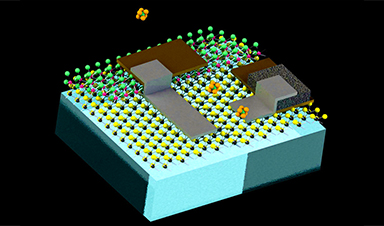AEROSOLS FOR GOOD. You may have sworn off aerosol sprays in the ’90s when everyone was talking about the hole in the ozone layer, but a team of researchers from MIT has found a use for aerosols that could be good for both the environment and our health. This spray contains nanobots, tiny sensors with the potential to do everything, from detecting dangerous leaks in pipelines, to diagnosing health issues. They published their research in Nature Nanotechnology on Monday.
NANO-SCALE SENSORS. Each sensor in the aerosol spray contains two parts. The first is a colloid, an extremely tiny insoluble particle or molecule. Colloids are so small, in fact, they can remain suspended in a liquid or the air indefinitely — the force of particles colliding around them is stronger than the force of gravity attempting to pull them down.
The second part of the sensor is a complex circuit containing a chemical detector built from a two-dimensional material, such as graphene. When this detector encounters a certain chemical in its environment, its ability to conduct electricity improves. The circuit also contains a photodiode, a device that can convert ambient light into electric current. This provides all the electricity needed to power the circuit’s data collection and memory.
Image Credit: Futurism.com
News This Week
Current Heart Health Guidelines Are Failing To Catch a Deadly Genetic Killer
New research reveals that standard screening misses most people with a common inherited cholesterol disorder. A Mayo Clinic study reports that current genetic screening guidelines overlook most people who have familial hypercholesterolemia, an inherited disorder that [...]
Scientists Identify the Evolutionary “Purpose” of Consciousness
Summary: Researchers at Ruhr University Bochum explore why consciousness evolved and why different species developed it in distinct ways. By comparing humans with birds, they show that complex awareness may arise through different neural architectures yet [...]
Novel mRNA therapy curbs antibiotic-resistant infections in preclinical lung models
Researchers at the Icahn School of Medicine at Mount Sinai and collaborators have reported early success with a novel mRNA-based therapy designed to combat antibiotic-resistant bacteria. The findings, published in Nature Biotechnology, show that in [...]
New skin-permeable polymer delivers insulin without needles
A breakthrough zwitterionic polymer slips through the skin’s toughest barriers, carrying insulin deep into tissue and normalizing blood sugar, offering patients a painless alternative to daily injections. A recent study published in the journal Nature examines [...]
Multifunctional Nanogels: A Breakthrough in Antibacterial Strategies
Antibiotic resistance is a growing concern - from human health to crop survival. A new study successfully uses nanogels to target and almost entirely inhibit the bacteria P. Aeruginosa. Recently published in Angewandte Chemie, the study [...]
Nanoflowers rejuvenate old and damaged human cells by replacing their mitochondria
Biomedical researchers at Texas A&M University may have discovered a way to stop or even reverse the decline of cellular energy production—a finding that could have revolutionary effects across medicine. Dr. Akhilesh K. Gaharwar [...]
The Stunning New Push to Protect the Invisible 99% of Life
Scientists worldwide have joined forces to build the first-ever roadmap for conserving Earth’s vast invisible majority—microbes. Their new IUCN Specialist Group reframes conservation by elevating microbial life to the same urgency as plants and [...]
Scientists Find a Way to Help the Brain Clear Alzheimer’s Plaques Naturally
Scientists have discovered that the brain may have a built-in way to fight Alzheimer’s. By activating a protein called Sox9, researchers were able to switch on star-shaped brain cells known as astrocytes and turn them into [...]














Leave A Comment